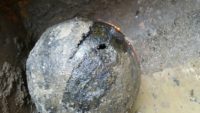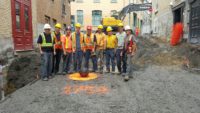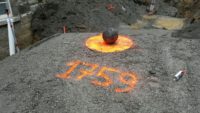 Last Friday, July 7th, a construction crew working on a building site at the corner of Hamel and Couillard streets in Old Quebec, the historic center of Quebec City, Canada, unearthed a large cannonball from the French and Indian War. The crew took pictures of themselves with the 200-pound projectile as if it were a movie star. They moved it around, struck poses and generally had a blast with their discovery.
Last Friday, July 7th, a construction crew working on a building site at the corner of Hamel and Couillard streets in Old Quebec, the historic center of Quebec City, Canada, unearthed a large cannonball from the French and Indian War. The crew took pictures of themselves with the 200-pound projectile as if it were a movie star. They moved it around, struck poses and generally had a blast with their discovery.
 They didn’t realize at the time that the blast they were having could well have been literal. It was archaeologist Serge Rouleau, called in by municipal authorities to examine the find, who saw that the ball still held a charge. His examination determined that the cannonball was of British manufacture and was fired at the old city in the Battle of the Plains of Abraham in 1759, or in the siege preceding it. Rouleau had taken the ball home with it to study — an odd step to take when dealing with explosive devices of any age — so when he realized his bouncing baby bomb still has what it takes to blow him up and burn his house down around the splattered specks of tissue that were once his body, he called in the experts.
They didn’t realize at the time that the blast they were having could well have been literal. It was archaeologist Serge Rouleau, called in by municipal authorities to examine the find, who saw that the ball still held a charge. His examination determined that the cannonball was of British manufacture and was fired at the old city in the Battle of the Plains of Abraham in 1759, or in the siege preceding it. Rouleau had taken the ball home with it to study — an odd step to take when dealing with explosive devices of any age — so when he realized his bouncing baby bomb still has what it takes to blow him up and burn his house down around the splattered specks of tissue that were once his body, he called in the experts.
A team of army munitions technicians was dispatched from CFB Valcartier to collect the ball and neutralize it.
“With time, humidity got into its interior and reduced its potential for exploding, but there’s still a danger,” said Master Warrant Officer Sylvain Trudel, a senior munitions technician.
Trudel said such balls were meant to set fire to the buildings they penetrated.
“The ball would break and the powder would ignite, setting fire to the building.”
 This was a brutal weapon in the mid-18th century, and Quebec City was deluged with them during the Seven Years’ War when Britain fought and shot its way to taking control of much of French North America. The Battle of the Plains of Abraham was the culmination of three months of intensive bombings by British troops besieging the city of Quebec. From the their position at Lévis, just across the St. Lawrence River from Quebec, the British launched a near-constant barrage of deadly artillery fire starting on July 12th, 1759. Over the next three months, they would set the city alight with 40,000 solid iron cannonballs and 8,000 incendiary bombs. On September 13th, the British and French engaged in an infantry battle on a plateau outside the city knows as the plans of Abraham. It lasted less than hour. The British were victorious, chasing the French out of the city and ending the siege. The siege and battle took a massive toll on Quebec and its environs. The city and surrounding countryside were in smoldering ruins when the smoke from the plains of Abraham cleared.
This was a brutal weapon in the mid-18th century, and Quebec City was deluged with them during the Seven Years’ War when Britain fought and shot its way to taking control of much of French North America. The Battle of the Plains of Abraham was the culmination of three months of intensive bombings by British troops besieging the city of Quebec. From the their position at Lévis, just across the St. Lawrence River from Quebec, the British launched a near-constant barrage of deadly artillery fire starting on July 12th, 1759. Over the next three months, they would set the city alight with 40,000 solid iron cannonballs and 8,000 incendiary bombs. On September 13th, the British and French engaged in an infantry battle on a plateau outside the city knows as the plans of Abraham. It lasted less than hour. The British were victorious, chasing the French out of the city and ending the siege. The siege and battle took a massive toll on Quebec and its environs. The city and surrounding countryside were in smoldering ruins when the smoke from the plains of Abraham cleared.
 On a global scale, the battle permanently altered Canadian geopolitics, setting the stage for the British conquest of Canada and the French withdrawal. France’s forces in Canada were weakened by the loss and came under increasing pressure from British troops on the continent. It would take another five years for the conflict to come to its final conclusion in the Treaty of Paris (1764), but when the quill pens were finally put to parchment, France had ceded almost all of its American territories, including Canada, to Britain.
On a global scale, the battle permanently altered Canadian geopolitics, setting the stage for the British conquest of Canada and the French withdrawal. France’s forces in Canada were weakened by the loss and came under increasing pressure from British troops on the continent. It would take another five years for the conflict to come to its final conclusion in the Treaty of Paris (1764), but when the quill pens were finally put to parchment, France had ceded almost all of its American territories, including Canada, to Britain.
 The 258-year-old live cannonball has now been moved out of the archaeologist’s house to a safe place where the munitions disposal experts will determine if it can be safely neutralized. If not, it will be detonated and destroyed.
The 258-year-old live cannonball has now been moved out of the archaeologist’s house to a safe place where the munitions disposal experts will determine if it can be safely neutralized. If not, it will be detonated and destroyed.
“Old munitions like this are hard to predict,” Trudel said. “You never know to what point the chemicals inside have degraded.”
If it is salvageable, the cannonball will find a loving forever home at a local museum.